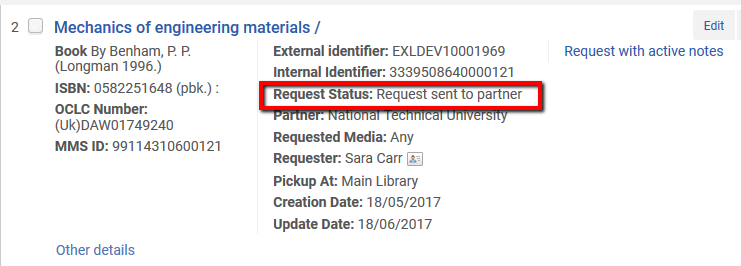General
How is copyright and access control supported for resource sharing?
Copyright and license management, in the context of resource sharing and fulfillment, is done at both the borrowing side and the lending side of the request processing:
Borrowing Side
Outgoing borrowing requests for receiving digital material are tracked by the system, based on a defined profile. For example, a request for a title which has a publishing date later than a defined date will be counted. When the number of fulfilled requests (within a defined period of time) reaches a threshold, management of subsequent requests for the same title are blocked until copyright cleared.
Clearing the block is done by managing the relevant copyright aspects, such as paying the relevant fees.
Lending Side
The lending side may fulfill incoming requests by using digital or electronic material of two types:
-
Digitally Stored Material—A resource sharing operator that consults Alma for a specific resource sharing request’s fulfillment options may get a list of suggested electronic resources that can be used for fulfilling the request. In this case, Alma will display the electronic resource’s terms of use alongside the resource’s link. The operator will be able to view the resource’s license in a single click, and make a decision on whether the electronic resource may be used for fulfilling the request or not.
-
Digitizing Physical Material—A resource sharing operator who consults Alma for a specific resource sharing request’s fulfillment options may get a list of suggested physical resources that can be used for fulfilling the request. In this case, Alma supplies alongside the description of the physical resource the possibility to request the use of the physical item in a digital form, i.e. to digitize the material.
Either way, the process may be configured to require copyright clearance. For example, a request for items with a publication data that is later than a specific date will require copyright clearance before the digitization process in complete. If this is the case, the digitization process will not be complete until the copyright clearance is signed off.
How are items in transit tracked from and to their home libraries?
The mechanisms for tracking items in transit for delivery from and to their home libraries depend on whether the resource sharing process is managed as a direct request/loan to the patron, or as a request/loan that is mediated by the borrowing patron’s institution.
If the resource sharing process is not mediated by the borrower’s institution (i.e. the loan and request are directly made by the borrowing patron), then Alma’s standard loan and item transit processes are used. In other words, as long as the item is held by the borrower, the standard loan control mechanisms for tracking overdue loans is used. After the item is checked in, standard transit routines are used to track where the item has been put in transit, where the item has been put in transit to, and when it is expected to arrive at its target destination. Like transits between libraries of the same institution, this information is based on delivery relationships that are set between the institutions, and the transit times that are defined for each relationship.
A resource sharing process that is mediated by the borrower’s institution is managed using Alma’s temporary locations. The item is registered as temporarily shelved at the resource sharing department at both the lender and borrower institution, throughout the resource sharing process. Being registered at a temporary location at both the borrower and lender side, standard processes for managing temporarily shelved inventory are used for managing the items. This includes processes such as:
- Reports for items that are due back to their permanent location
- Automatic requests being placed to reshelve the items back to their permanent shelving locations
How can staff track the status of borrowing and lending requests including requests to the BL?
Staff can track the progress of requests by checking 'Borrowing Requests' in Alma. The current status of requests will display and for BL requests will update automatically based on responses from BL via the BLDSS API. Staff can also update the status of requests manually if required.
For requests borrowed directly from other institutions, their status can be tracked/updated in Borrowing Requests. Their status will also update automatically depending on updates from the lending partner, if the lending partner is also using Alma or another ISO-ILL compliant system.

For requests supplied directly to other institutions, their status can be tracked/updated in Lending Requests. Their status will also update automatically depending on updates from the borrowing partner, if the borrowing partner is also using Alma or another ISO-ILL compliant system.
Does Alma integrate with Tipasa?
Using NCIP it is possible to integrate Alma with Tipasa as a broker. The Tipasa integration is similar to other broker integrations in Alma - where the borrowing library communicates with an ILL broker. The broker passes the request to potential suppliers, and handles the request against the borrowing library.
The following messages are supported by this integration:
Borrower Side:
- Accept Item – When physical item is received
- Check In Item – When physical item is sent back to the lender
- Create User Fiscal Transaction – For creating a request fee
Lender Side:
- Check Out Item – When item is shipped to the borrower
- Check In Item – When item is received back from the borrower
Total views:
1209
